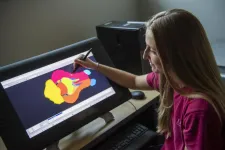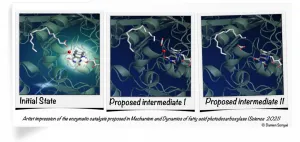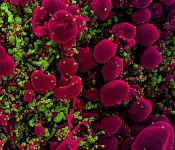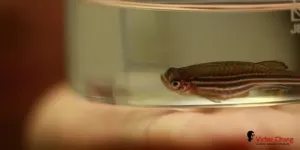(Press-News.org) URBANA, Ill. - When scientists need to understand the effects of new infant formula ingredients on brain development, it's rarely possible for them to carry out initial safety studies with human subjects. After all, few parents are willing to hand over their newborns to test unproven ingredients.
Enter the domestic pig. Its brain and gut development are strikingly similar to human infants - much more so than traditional lab animals, rats and mice. And, like infants, young pigs can be scanned using clinically available equipment, including non-invasive magnetic resonance imaging, or MRI. That means researchers can test nutritional interventions in pigs, look at their effects on the developing brain via MRI, and make educated predictions about how those same nutrients will affect human infants.
For nearly a decade, scientists have relied on an MRI-based map, or atlas, of the pig brain - developed at the University of Illinois using 4-week-old pigs - to understand where and how nutrients and other interventions affect the developing brain. Now, Illinois scientists have updated that atlas, increasing its resolution by a factor of four, and they have also added a new atlas for adolescent 12-week-old pigs.
The new atlases are freely available for download at pigmri.illinois.edu.
"That improvement in spatial resolution makes a huge difference when you're looking at development in a small pig brain and trying to see how your intervention is changing structure, size, or even function in the brain," says Brad Sutton, professor in the Department of Bioengineering, technical director of the Biomedical Imaging Center at Illinois' Beckman Institute, and a co-author on the brain atlas study, published in the Journal of Neuroscience Methods.
Ryan Dilger, associate professor in the Department of Animal Sciences and senior author on the atlas study, adds, "It's about our ability to discern one part of the brain from another. The higher the resolution, the more reliably we can say this piece is the hippocampus, for example. Part of the need for an atlas is for every research group working in this area to be referencing the same parts or regions of the brain consistently. We have to have common terms and infrastructure to speak the same language."
To build the updated atlas, the researchers anesthetized and scanned 4- and 12-week old pigs at Beckman's Biomedical Imaging Center using a state-of-the-art Siemens Prisma 3 T MRI scanner. Scans from multiple pigs in each age class were averaged into a single atlas for each age, to account for variation among individuals. Subsequently, the researchers identified and digitally isolated 26 regions of interest, such as the cerebellum, medulla, right and left cortex, and others, and provided volumetric standards for each in the pig.
"We provide the absolute and relative volumes for not only the whole brain, but tissues such as gray matter, white matter, cerebrospinal fluid, as well as all the different regions of interest. That normative data can act as a reference for other individuals who might be interested in seeing how a particular intervention influences brain growth or development in the pig," says Joanne Fil, doctoral student in the Neuroscience Program at Illinois and lead author on the atlas study.
The previous pig brain atlas has been used by researchers to advance neuroscience around the world, with some 450 downloads to date. The collective discoveries made possible by the atlas go well beyond pediatric nutrition to include deeper understanding of the microbiota-gut-brain axis, which appears to relate to common clinical situations.
Dilger says the new atlas will give researchers an even more precise view of the brain, enabling more advanced discoveries. And with the addition of the atlas for older pigs, they'll be able to extend their findings even farther.
"At 24 weeks of age, or six months, the pig is sexually mature. We would expect that by this age, the pig would have most, if not all, of its brain development completed," Fil says. "So now we're able to see how our interventions impact development not only at an early age, but also into adulthood in the pig."
Fil adds the study also provides a detailed account of the process they used to create the atlas, giving researchers the blueprints to create additional atlases for other animals.
But there's a lot to be said for pigs as an important biomedical research animal.
"You can study brain development in a mouse, but for some studies, the mouse brain is not similar to a human brain in some important aspects. Also, you can't really study intervention effects on the brain directly in humans, because although we can get people in the scanner, we can't always modify their diet and test out different components," Sutton says.
"So the pig is right in that sweet spot: its brain is the right size to use human MRI scanners and pig brain development closely matches that of humans. And we have tools to be able to study it in great detail, especially on this campus, and do great things with it. The pig is perfect for studying the brain."
Dilger adds, "We are using the actual human clinical equipment in the pig. We're effectively, non-invasively, taking a microscope to the pig brain while it's still alive. That's the benefit. We can take a virtual peek inside the pig brain multiple times throughout the life of the pig to see how the brain is structurally developing."
INFORMATION:
The article, "High resolution magnetic resonance imaging-based atlases for the young and adolescent domesticated pig (Sus scrofa)," is published in the Journal of Neuroscience Methods [DOI: 10.1016/j.jneumeth.2021.109107]. Authors include Fil, Sutton, Dilger, and Sangyun Joung, and Benjamin Zimmerman. Funding was provided by USDA's National Institute of Food and Agriculture.
The Department of Animal Sciences is in the College of Agricultural, Consumer and Environmental Sciences at the University of Illinois.
Modern human-like brains evolved comparatively late in the genus Homo and long after the earliest humans first dispersed from Africa, according to a new study. By analyzing the impressions left behind by the ancient brains that once sat inside now fossilized skulls, the authors discovered that the brains of the earliest Homo retained a primitive, great ape-like organization of the frontal lobe. The findings challenge the long-standing assumption that human-like brain organization is a hallmark of early Homo and suggest that the evolutionary history of the human brain is more complex than previously thought. Our modern brains are larger and structurally different than those of our closest living relatives, ...
Researchers present a new, low-temperature method for injection-molding transparent fused silica glass, similar to how many plastic objects are manufactured. According to the authors, the process offers the possibility of producing complex and high-quality glass components using the same fabrication methods that allowed polymers to become one of the most important materials of the 21st century. The optical, thermal, mechanical and chemical properties of silicate glasses make them an ideal non-carbon based, high-performance material with applications ranging from packaging and architecture to high-throughput fiber optic ...
Using a novel genetic editing system termed intMEMOIR, researchers reveal the cell lineage histories of individual cells within their native tissue context, according to a new study. The new approach provides a powerful new tool for recording cell lineage in diverse cellular systems. During multicellular development, a cell's spatial position and lineage play important roles in cell fate determination. The ability to visualize lineage relationships directly within their native tissues can provide valuable insight into the factors that affect development and disease. This promise has spurred the development of several ...
X-ray emissions from the Crab Pulsar are more intense during giant radio pulses (GRPs), researchers report. The new findings provide constraints on the mechanisms underlying GRPs and may provide insights into other transient radio phenomena observed throughout the Universe. Pulsars, or rapidly spinning neutron stars, emit pulses of electromagnetic radiation from their magnetospheres and are observed from Earth as regular sequences of radio pulses. Most radio pulses from these distant objects are of a consistent intensity. Occasionally, however, sporadic and short-lived ...
The functioning of the enzyme FAP, useful for producing biofuels and for green chemistry, has been decrypted. This result mobilized an international team of scientists, including many French researchers from the CEA, CNRS, Inserm, École Polytechnique, the universities of Grenoble Alpes, Paris-Saclay and Aix Marseille, as well as the European Synchrotron (ESRF) and synchrotron SOLEIL. The study is published in Science on April 09, 2021.
The researchers decrypted the operating mechanisms of FAP (Fatty Acid Photodecarboxylase), which is naturally present in microscopic algae such as Chlorella. The enzyme had been identified in 2017 as able to use light energy to form hydrocarbons from fatty acids ...
Two studies published in the open-access journal PLOS Pathogens provide new evidence supporting an important role for the immune system in shaping the evolution of SARS-CoV-2, the virus that causes COVID-19. These findings--and the novel technology behind them--improve understanding of how new SARS-CoV-2 strains arise, which could help guide treatment and vaccination efforts.
For the first study, Rachel Eguia of Fred Hutchinson Cancer Research Center in Seattle, Washington, and colleagues sought to better understand SARS-CoV-2 by investigating a closely related virus that has circulated widely for a far longer period of time: the common-cold virus ...
A group led by scientists from the RIKEN Cluster for Pioneering Research, using coordinated observations of the Crab pulsar in a number of frequencies, have discovered that the "giant radio pulses" which it emits include an increase in x-ray emissions in addition to the radio and visible light emissions that had been previously observed. This finding, published in Science, implies that these pulses are hundreds of times more energetic than previously believed and could provide insights into the mysterious phenomenon of "fast radio bursts (FRBs)."
Giant radio pulses--a phenomenon where extremely short, millisecond-duration pulses of radio waves are emitted--have ...
Researchers at the Francis Crick Institute have found that blocking a specific protein could increase tumour sensitivity to treatment with PARP inhibitors. Their work published in Science , suggests combining treatments could lead to improved therapy for patients with inheritable breast cancers.
Some cancers, including certain breast, ovarian and prostate tumours, are caused by a fault in the BRCA1 or BRCA2 genes, which are important for DNA repair. Treatment for these cancers has greatly improved thanks to the discovery of PARP inhibitors, drugs which capitalise on this weakness in the cancer ...
Scientists at the Victor Chang Cardiac Research Institute in Sydney have discovered a critical new gene that it is hoped could help human hearts repair damaged heart muscle after a heart attack.
Researchers have identified a genetic switch in zebrafish that turns on cells allowing them to divide and multiply after a heart attack, resulting in the complete regeneration and healing of damaged heart muscle in these fish.
It's already known that zebrafish can heal their own hearts, but how they performed this incredible feat remained unknown, until now. In research recently published in the prestigious journal, Science, the team at the Institute drilled down into a critical ...
Modern humans are fundamentally different from our closest living relatives, the great apes: We live on the ground, walk on two legs and have much larger brains. The first populations of the genus Homo emerged in Africa about 2.5 million years ago. They already walked upright, but their brains were only about half the size of today's humans. These earliest Homo populations in Africa had primitive ape-like brains - just like their extinct ancestors, the australopithecines. So when and where did the typical human brain evolve?
CT comparisons of skulls reveal modern brain structures
An international ...




